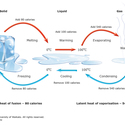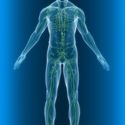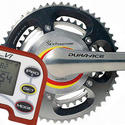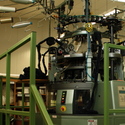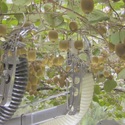If you’re visiting Dale Carnegie and his Mechatronics team at Victoria University, don’t be scared when you are approached by MARVIN (short for Mobile Autonomous1 Robotic Vehicle for Indoor Navigation), a very sophisticated security guard.
MARVIN is designed to wander the university corridors and detect intruders, but to do this, he must have a wide range of sensors and a means to interpret the information.
MARVIN is equipped with a number of different sensors that he can use to detect changes in his environment. He ‘sees’ using infrared2 sensors, he ‘hears’ through electric sensors sensing sound and ‘feels’ through touch sensors. These sensors send electrical signals to other components that may trigger a response, for example, MARVIN can change his body posture to assume a more aggressive stance if provoked.
MARVIN is also a research tool that Dale Carnegie and his team use to develop new ideas, for example, a new sensor is being developed that is similar to a human eye that will allow MARVIN to find the range of every item in front of him.
Search and rescue robots
When the World Trade Centre in New York collapsed in 2001, a robotics team from Florida was sent in to try and find survivors. Unfortunately, they were unable to find a single living person. Part of the problem was that these robots were very large and couldn’t penetrate much of the rubble. Their large size was due to big batteries needed to run a lot of electrical circuits and components used for sensing and responding mechanically.
Dale Carnegie’s team have developed a different way of designing rescue robots. Instead of one large robot, they are constructing a system of robots that communicate with one another electronically. They have developed a 3-tiered system consisting of a ‘grandmother’ robot, several ‘mother’ robots and up to 200 ‘daughter’ robots.
The grandmother is a large, complex robot designed to act as a launch platform for the mothers and as a base station where it processes and controls the information sent to and from the other robots. The grandmother does not enter the disaster zone, so her size is not a problem. The smaller mother robots are able to travel over rough ground and contain many sensors for mapping and navigation. When they sense a gap in the rubble, they dispatch a daughter robot into the gap.
The daughters are launched from the mother, with a range of only 100 metres3. They are small enough to crawl into small gaps in the rubble and are equipped with electronic sensors to detect a trapped human. These sensors may detect movement, heat4, sound and even gases5 such as carbon dioxide6. The daughter robots are very small, about the size of a credit card, and are designed to be completely disposable. It is not expected that any of them will be recovered once launched from the mother.
The information from the daughters’ sensors is sent back to the mother robot, and she relays the information from the daughters to the grandmother for processing.
So instead of putting all the information gathering and analysis of data7 into one robot, the team at Victoria have separated the tasks and designed robots of different sizes to carry out different tasks.
An analogy8 of how the system functions is that the grandmother acts as the brain, the mothers act as the arms or legs, and the daughters act as the skin (detecting heat), eyes and ears. Specialised electrical circuits form the basis for these sensing activities.
The robots that were sent into the World Trade Centre disaster were expensive and required skilled operators, but Dale’s grandmother robot is the skilled operator, controlling up to 200 daughters – this means a disaster area can be covered with many more sensors than the ‘do everything’ robots used in previous rescue situations. The daughter robots aren’t recovered from the disaster scene, but because they are disposable, their design can be kept much simpler and cheaper.
Nature of science
An increasing number of research projects are cross-disciplinary, bringing together ideas and researchers from different scientific fields. The study of mechatronics brings together electronics9, mechanical engineering10 and computer programming, and has led to the development of specialised robots.
Related content
The article Electricity and sensors explains the basics of electric currents, circuits, conductivity and switches.
Activity ideas
These activities help introduce students to the science of electrical circuits.
- Testing for conductivity involves the construction of simple electrical circuits to test a variety of materials for their conductive abilities.
- Sensing moisture involves the construction of a simple, effective moisture sensor.
- autonomous: A machine that is able to operate on its own with little or no human control. A lifeform that exists and functions as an independent organism.
- infrared: Invisible electromagnetic radiation with a wavelength between approximately 0.75 micrometres and 1 millimetre. Infrared occurs between the red end of the visible light spectrum and microwaves. All things over a certain temperature (absolute zero) absorb and emit infrared radiation. Infrared radiation and observing technologies are used in many industries from medicine to finding people buried under rubble and by the military and others in night-vision goggles.
- metre: The base unit of length in the International System of Units (SI).
- heat energy (heat): Heat energy: the transfer of energy in materials from the random movement of the particles in that material. The greater the random movement of particles the more heat energy the material has. Temperature is a measure of the heat energy of a material.
Heat: the flow of energy from a warm object to a cooler object. - gases: The state of matter distinguished from the solid and liquid states. Gases have the ability to diffuse readily and to become distributed uniformly throughout any container.
- carbon dioxide: CO2 is a colourless, odourless, incombustible gas. It is a product of cellular respiration and combustion and is an essential component in photosynthesis.
- data: The unprocessed information we analyse to gain knowledge.
- analogy: A comparison between two things, usually using something that is easy to understand to explain something that is more complicated.
- electronics: 1. The study of the behaviour and control of electrons. This field has expanded enormously with the discovery of semiconductors. 2. The generic term for hardware used to build electrical components.
- mechanical engineering: A branch of engineering that deals with the design, construction and operation of machinery.


